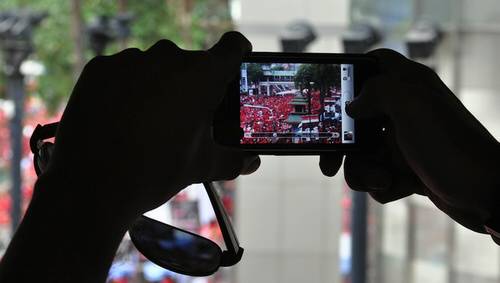
The next Hollywood blockbuster may not be made using a smartphone, but that day is soon coming. This year’s Academy Award winner for Best Documentary Feature, Searching for Sugarman, was shot mostly on traditional, costly 8mm film. The director shot some final scenes, however, with his iPhone and the $2 app 8mm Vintage Camera. Increasingly, high-quality films – shorts, especially – are being made entirely with nothing more than a smartphone.
Today’s high-end smartphones pack a virtual film studio in your pocket. The Nokia Lumia 920, for example, includes a 1080p full-HD video camera, zoom light, image stabilization and multiple white balance modes to help ensure that perfect shot.
Specs aren’t enough to convince you?
Blackberry has teamed up with famed Sin City director, Robert Rodriguez, to create a short film using the new Blackberry Z10. Former Cannes film festival winner, Park Chan-wook, used a smartphone to film Paranmanjan – it won the Golden Bear for Best Short Film at the 2011 Berlin Film Festival.
Not only are smarpthone-shot films making it into film festivals, smartphone-only film festivals are cropping up around the world, such as the Mobil Film Festival in San Diego, the Pocket Film Festival in Paris and the Olleh International Smartphone Film Festival in Korea.
Each of these festivals showcase the device’s potential for creating stirring films while enabling those with the talent, no matter where they may be located, to unleash their creative potential.
Personal Filmmaking on a Global Scale
Despite their limitations, smartphones do offer some unique advantages over traditional filmmaking. Smartphone films can be made on a very low budget – which likely encourages risk-taking that traditional filmmaking shuns. Smartphones can film almost anywhere – and they are with us nearly everywhere. The portable nature of the device allows for more intimate moments and increases opportunities for filmmaking with a more personal viewpoint. Smartphones allow those who traditionally are rarely portrayed in films, such as those in impoverished areas around the world, to now be seen. With a smartphone and YouTube, immediate global distribution is possible.
For example, at the third annual Olleh smartphone film festival in Korea, smartphone-made films from around the world were submitted. Last weekend, twenty-five films were screened by the jury for public viewing. All are now available on YouTube. Winners included:
[Note: Some videos below contain foul language]
24 Months Later (Grand Prize and Audience favorite)
Great, even if the whole zombie thing has gotten a bit overplayed.
Tell Me About Yourself (Best Actor award)
Short, funny and probably not safe for sharing with your boss.
Board Maker (Special Youth Award winner)
I confess, I did not get this.
The Opportunity is Everywhere
There is a growing movement – and market – for smartphone films. There are numerous apps to help the budding smartphone filmmaker improve their story outline, streamline the editing process and even maximize time spent shooting in sunlight. There is also a growing market for accessories. These include everything from optional lenses, to an iPhone “dolly” and smartphone “steadicam.”
Need funding for your film? Over $128 million has been pledged on Kickstarter for film and video projects. It’s quite possible that very soon many if not most crowdfunded films will be shot entirely with a smartphone.
Still hesitant?
The Guardian asked director Matt Carroll for tips. His advice includes methods to improve sound and post-film editing, and guidance on the all-important topic of lighting:
The (smartphone) camera doesn’t see subtle light gradations like we do, so it’s best to avoid areas of high contrast. For example, if it’s a sunny day and you’re filming someone under an awning, the chances are they’ll come out too dark or the background will be bleached out (‘burnt’).
Need more help?
In France, Pocket Film Festival founder Benoît Labourdette conducts workshops to help smartphone filmmakers. His primary advice is to use your phone’s natural advantage – its size and portability – to get shots that are inaccessible to traditional cameras.
Far removed from Hollywood?
The World Film Collective teaches youth in impoverished areas – from Africa and South America, to inner cities in the UK – to make films using only a smartphone.
The result?
Smartphones are rapidly becoming the tools people across the planet are using to tell their stories and show them to the world.
Lead image courtesy of Shutterstock.









